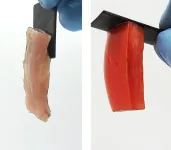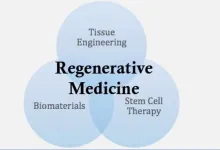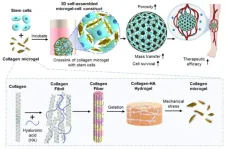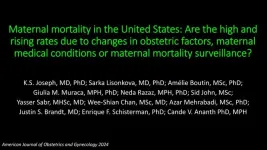You don’t need glue to hold these materials together — just electricity
2024-03-13
(Press-News.org) Is there a way to stick hard and soft materials together without any tape, glue or epoxy? A new study published in ACS Central Science shows that applying a small voltage to certain objects forms chemical bonds that securely link the objects together. Reversing the direction of electron flow easily separates the two materials. This electroadhesion effect could help create biohybrid robots, improve biomedical implants and enable new battery technologies.
When an adhesive is used to attach two things, it binds the surfaces either through mechanical or electrostatic forces. But sometimes those attractions or bonds are difficult, if not impossible, to undo. As an alternative, reversible adhesion methods are being explored, including electroadhesion (EA). Though the term is used to describe a few different phenomena, one definition involves running an electric current through two materials causing them to stick together, thanks to attractions or chemical bonds. Previously, Srinivasa Raghavan and colleagues demonstrated that EA can hold soft, oppositely charged materials together, and even be used to build simple structures. This time, they wanted to see if EA could reversibly bind a hard material, such as graphite, to a soft material, such as animal tissue.
The team first tested EA using two graphite electrodes and an acrylamide gel. A small voltage (5 volts) was applied for a few minutes, causing the gel to permanently adhere to the positively charged electrode. The resulting chemical bond was so strong that, when one of the researchers tried to wrench the two pieces apart, the gel tore before it disconnected from the electrode. Notably, when the current’s direction was reversed, the graphite and gel easily separated — and the gel instead adhered to the other electrode, which was now positively charged. Similar tests were run on a variety of materials — metals, various gel compositions, animal tissues, fruits and veggies — to determine the phenomenon’s ubiquity.
For EA to occur, the authors found that the hard material needs to conduct electrons, and the soft material needs to contain salt ions They hypothesize that the adhesion arises from chemical bonds that form between the surfaces after an exchange of electrons. This may explain why some metals that hold onto their electrons strongly, including titanium, and some fruits that contain more sugar than salts, including grapes, failed to adhere in some situations. A final experiment showed that EA can occur completely underwater, revealing an even wider range of possible applications. The team says that this work could help create new batteries, enable biohybrid robotics, enhance biomedical implants and much more.
The authors do not acknowledge a funding source for this work.
The paper’s abstract will be available on Mar. 13 at 8 a.m. Eastern time here: http://pubs.acs.org/doi/abs/10.1021/acscentsci.3c01593
For more of the latest research news, register for our upcoming meeting, ACS Spring 2024. Journalists and public information officers are encouraged to apply for complimentary press registration by completing this form.
###
The American Chemical Society (ACS) is a nonprofit organization chartered by the U.S. Congress. ACS’ mission is to advance the broader chemistry enterprise and its practitioners for the benefit of Earth and all its people. The Society is a global leader in promoting excellence in science education and providing access to chemistry-related information and research through its multiple research solutions, peer-reviewed journals, scientific conferences, eBooks and weekly news periodical Chemical & Engineering News. ACS journals are among the most cited, most trusted and most read within the scientific literature; however, ACS itself does not conduct chemical research. As a leader in scientific information solutions, its CAS division partners with global innovators to accelerate breakthroughs by curating, connecting and analyzing the world’s scientific knowledge. ACS’ main offices are in Washington, D.C., and Columbus, Ohio.
To automatically receive news releases from the American Chemical Society, contact newsroom@acs.org.
Note: ACS does not conduct research, but publishes and publicizes peer-reviewed scientific studies.
Follow us: X, formerly Twitter | Facebook | LinkedIn | Instagram
END
[Attachments] See images for this press release:

ELSE PRESS RELEASES FROM THIS DATE:
2024-03-13
A new study reveals that many people living in extreme poverty in low- and middle-income countries (LMICs) have conditions that lead to heart disease, the world’s #1 cause of death — overturning ‘conventional wisdom’.
In the largest analysis of its kind exploring the relationship between poverty and cardiovascular disease (CVD) risk factors, experts discovered a high prevalence of hypertension, diabetes, smoking, obesity, and dyslipidemia in LMICs regardless of income —yet most adults living in extreme poverty were not treated for these CVD-related conditions.
An international group of researchers note that their findings, ...
2024-03-13
A study led by the Barcelona Institute for Global Health (ISGlobal), a centre supported by the "la Caixa" Foundation, and the Barcelona Supercomputing Center - Centro Nacional de Supercomputación (BSC-CNS), has consistently estimated daily ambient concentrations of PM2.5, PM10, NO2 and O3 across a large ensemble of European regions between 2003 and 2019 based on machine learning techniques. The aim was to assess the occurrence of days exceeding the 2021 guidelines of the World Health Organization (WHO) for one or multiple pollutants, referred to as “unclean air days”.
The ...
2024-03-13
SPOKANE, Wash. – Exposure to several combinations of toxic atmospheric pollutants may be triggering asthma symptoms among children, a recent analysis suggests.
The study, published in the journal Science of the Total Environment, showed that 25 different combinations of air pollutants were associated with asthma symptoms among 269 elementary school children diagnosed with asthma in Spokane, Washington. In line with previous research, the Washington State University-led study revealed a socioeconomic disparity—with one group of children from a lower-income neighborhood exposed to more toxic combinations, a total of 13 of the 25 ...
2024-03-13
LA JOLLA, CA—Hitting targets embedded within the cell membrane has long been difficult for drug developers due to the membrane’s challenging biochemical properties. Now, Scripps Research chemists have demonstrated new custom-designed proteins that can efficiently reach these “intramembrane” targets.
In their study, published March 13, 2024, in Nature Chemical Biology, the researchers used a unique computer-based approach to design novel proteins targeting the membrane-spanning region of the erythropoietin (EPO) receptor, which controls red blood cell production and can go awry in cancers. In addition ...
2024-03-13
A largescale new study has found that some people whose genetics are linked to the common iron overload condition haemochromatosis have substantially greater levels of liver, musculoskeletal and brain disease than previously reported, especially at older ages.
Haemochromatosis causes a build-up of iron in the body which can cause harm to joints and organs – although the extent of this harm is unclear, especially in older ages. The new research, led by a team at the University of Exeter and supported by the National Institute for Health and Care ...
2024-03-13
One of the primary goals in the field of tissue engineering and regenerative medicine is the development of artificial scaffolds that can serve as substitutes for damaged tissue. These materials must ideally resemble natural tissue and must have the ability to support cell adhesion, proliferation, and differentiation. When considering scaffold materials, researchers account for the scaffold’s properties, such as its surface roughness, its water content (hydration state), and its flexibility or stiffness (elastic modulus), since these properties are known to affect cell ...
2024-03-13
Critical limb ischemia is a condition in which the main blood vessels supplying blood to the legs are blocked, causing blood flow to gradually decrease as atherosclerosis progresses in the peripheral arteries. It is a severe form of peripheral artery disease that causes progressive closure of arteries in the lower extremity, leading to the necrosis of the leg tissue and eventual amputation. Current treatments include angioplasty procedures such as stent implantation and anti-thrombotic drugs, but there is a risk of blood vessel damage and recurrence of blood clots, which is why there is a strong interest ...
2024-03-13
Philadelphia, March 13, 2024 – A new study published in the American Journal of Obstetrics & Gynecology, published by Elsevier, challenges the prevailing view on the maternal death rate in the United States. The findings show that the rates of maternal death were stable between 1999-2002 and 2018-2021, instead of the dramatic upward trends previously reported by the National Vital Statistics System (NVSS), Centers for Disease Control and Prevention (CDC). Additionally, the study indicates that direct obstetric causes of death declined over the last 20 years.
To determine whether the reported maternal death rates are accurate, a team of researchers took a deep dive into ...
2024-03-13
Maternal death rates in the United States may be sharply overstated as a result of faulty surveillance techniques, according to an analysis by researchers at Rutgers Health and other universities.
The National Vital Statistics System (NVSS) of the Centers for Disease Control and Prevention (CDC) estimates that maternal death rates have more than tripled over the last two decades to 32.9 deaths per 100,000 live births in 2021 – substantially more than in any other wealthy nation.
The new study that looked at all deaths in the United States from 1999 to 2021 published in The American Journal of Obstetrics and Gynecology reports consistent death rates of slightly ...
2024-03-13
What: Researchers at the National Institutes of Health (NIH) have discovered that symptoms of attention-deficit/hyperactivity disorder (ADHD) are tied to atypical interactions between the brain’s frontal cortex and information processing centers deep in the brain. The researchers examined more than 10,000 functional brain images of youth with ADHD and published their results in the American Journal of Psychiatry. The study was led by researchers at NIH’s National Institute of Mental Health (NIMH) and National Human Genome Research Institute.
Luke Norman, Ph.D., a staff scientist in the NIMH Office of the Clinical Director, and colleagues ...
LAST 30 PRESS RELEASES:
[Press-News.org] You don’t need glue to hold these materials together — just electricity




